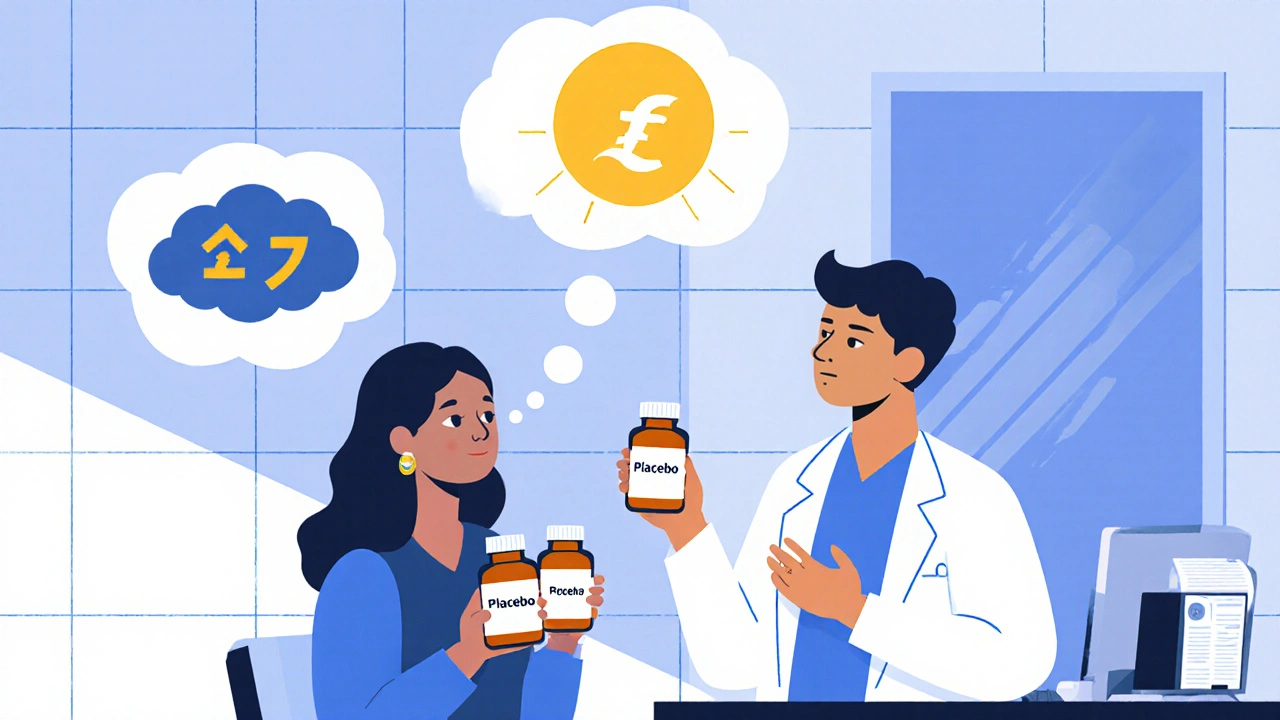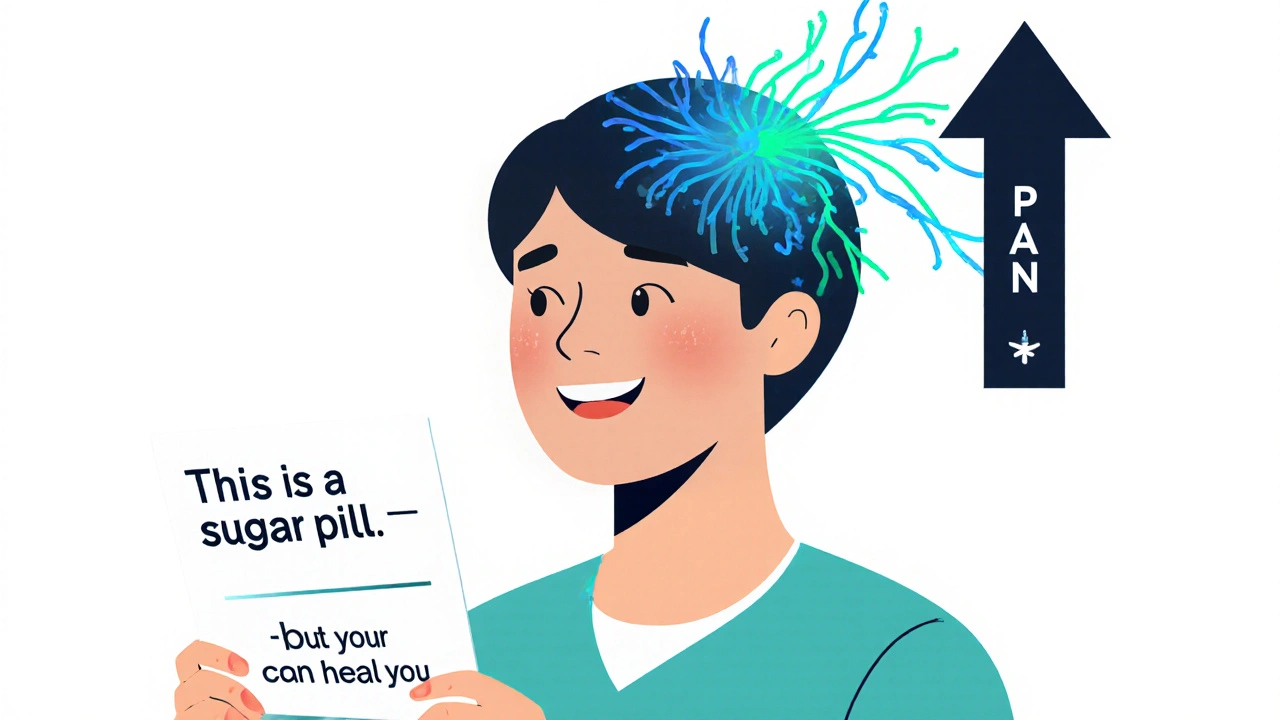
Nocebo Risk Calculator
Your Risk Factors
Answer these questions to determine your personal risk of experiencing nocebo effects
Risk Results
Actionable Recommendations
When you take a pill, your body doesn’t just react to the chemicals inside it. It also reacts to what you expect will happen. That’s where the placebo and nocebo effects come in - two powerful forces shaping how you feel during treatment, even when the medicine itself isn’t doing anything active.
What’s the Difference Between Placebo and Nocebo?
A placebo is an inert substance - like a sugar pill - that has no medicinal properties. Yet, many people report feeling better after taking it. That’s the placebo effect: your brain, convinced the treatment will help, triggers real physiological changes that ease pain, reduce anxiety, or improve mood.
The nocebo effect is its dark twin. It happens when you expect something bad - like nausea, dizziness, or fatigue - and then you start feeling those symptoms, even if you’re taking a fake pill. The word comes from Latin: placebo means "I shall please," and nocebo means "I shall harm."
Here’s the startling part: in clinical trials, 50% to 76% of all reported side effects happen in the placebo group. That means half the people who say they got headaches or stomach pain from a drug might have felt those symptoms simply because they were told those side effects were possible.
How Strong Is the Nocebo Effect?
Recent research from 2025 shows nocebo effects aren’t just common - they’re stronger than placebo effects. In a controlled study, participants who were warned about side effects reported significantly worse symptoms than those who weren’t, even when both groups got identical sugar pills. The nocebo group had higher cortisol levels, increased heart rate, and more reported fatigue. And unlike placebo effects, which often fade over time, nocebo effects stick around.
One study found that nocebo symptoms decreased by only 5% over eight days, while placebo effects stayed steady. That means negative expectations don’t just fade away - they linger, shaping how patients experience treatment long after the first dose.
Where Do Nocebo Effects Come From?
It’s not magic. It’s biology. Brain scans show that when people expect pain or side effects, areas like the anterior cingulate cortex and insula light up - the same regions that process real pain and stress. Your body isn’t faking it. It’s responding to belief as if it were real.
Three main sources trigger nocebo responses:
- Verbal suggestions - when doctors or leaflets list side effects, you’re more likely to notice them. This accounts for 70-80% of cases.
- Observational learning - hearing someone else say, "This drug made me sick," can plant the seed in your mind.
- Past experiences - if you had bad side effects before, you’re more likely to expect them again, even with a different drug.
For example, in trials for migraine meds, 20-30% of people on placebo pills reported nausea, dizziness, or fatigue - exactly the side effects listed for the real drug. Same with antidepressants: 25-35% of placebo-takers reported new anxiety or insomnia. These aren’t random. They’re mirror images of what patients were told to expect.

Real-World Impact: From Symptoms to Stopped Medications
This isn’t just about feeling a little off. Nocebo effects directly affect whether people stick with their treatment.
One study found that 25-35% of patients quit their medication because they believed they were experiencing side effects - even when those symptoms were caused by the nocebo effect. That means people stop taking blood pressure pills, antidepressants, or cholesterol drugs not because the drugs are harmful, but because they thought they’d be.
And it’s expensive. In the U.S. alone, nocebo-related visits to doctors, unnecessary tests, and extra medications cost an estimated $1.2 billion a year. Patients go to urgent care for headaches they think are from a drug, get blood work done, and sometimes even get prescribed another drug to treat the side effect - which might then cause its own nocebo response. It’s a cycle.
During the COVID-19 vaccine rollout, 76% of people who got a placebo shot reported fatigue or headache - symptoms identical to those reported by people who got the real vaccine. Many of those people thought they were reacting to the vaccine, when their body was just responding to fear.
How Doctors Can Reduce Nocebo Effects
Doctors aren’t trying to trick patients. Informed consent is essential. But how they deliver information matters more than most realize.
Here’s what works:
- Use absolute numbers, not percentages. Saying "3 out of 100 people get this side effect" is less alarming than "3% risk." Studies show this cuts nocebo reports by 15-25%.
- Frame side effects as temporary and manageable. Instead of "You might get nausea," try "Some people feel a bit queasy for a day or two - it usually passes quickly and can be eased with food or rest."
- Acknowledge the possibility, then pivot to benefit. "Some people feel a headache at first, but most find their energy improves within a week."
- Check for past negative experiences. Patients who’ve had bad reactions before are 3.1 times more likely to have nocebo responses. Ask about it.
Some clinics now use digital tools that analyze a patient’s tone, word choice, and history to predict nocebo risk. If someone has anxiety, a history of catastrophizing, or previous bad experiences with meds, the system flags it so the doctor can adjust their language.

Open-Label Placebos: The Surprising Fix
Here’s the twist: you don’t even need to lie to get a benefit.
In a groundbreaking study, patients with chronic pain were told outright: "You’re getting a placebo - no active ingredients. But placebos have been shown to help pain through your brain’s natural healing response." Many still reported reduced pain. Some improved as much as those on real medication.
This is called an open-label placebo. It works because the brain responds to ritual, attention, and belief - not deception. The act of taking a pill, the care from the provider, the expectation of help - all of it triggers real biological change.
Same with irritable bowel syndrome: patients given open-label placebos had 25-35% less pain and bloating than those who got nothing. The body doesn’t care if the pill is real - it cares if you believe it can help.
What’s Changing in Medicine?
Regulators are catching on. The European Medicines Agency now requires nocebo effect analysis in drug safety reports. The FDA is developing statistical models to separate true drug side effects from nocebo responses - because right now, a lot of "side effects" listed on drug labels are actually nocebo.
Pharmaceutical companies are spending $50-75 million per drug just to design better patient information materials. They’re hiring behavioral scientists to rewrite leaflets so they don’t accidentally scare people into feeling worse.
And research is moving fast. Scientists are now looking at genetics - people with certain versions of the COMT gene are 2.5 times more likely to have strong nocebo responses. AI tools are being tested to detect nocebo risk during consultations by analyzing speech patterns and emotional tone.
By 2025, new guidelines will likely require drug companies to report nocebo rates alongside efficacy data. That means future drug labels might say: "70% of reported headaches in this trial occurred in patients taking placebo."
What This Means for You
If you’re on medication and feel side effects, don’t assume they’re from the drug. Ask: Could this be my brain responding to what I was told?
Keep a simple log: when did the symptom start? Did it appear right after you read the leaflet or heard someone else’s story? Did it get worse when you worried about it? Sometimes, symptoms fade when you realize they’re tied to fear, not chemistry.
And if you’re a patient who’s stopped a medication because of side effects - consider talking to your doctor again. You might be able to restart it with better communication, lower anxiety, and a different mindset. The medicine might still work. And the side effects might just disappear.
The mind isn’t just along for the ride. It’s driving. And understanding that changes everything about how we take care of ourselves - and each other.
Can placebo pills really make people feel better?
Yes. Studies show placebo pills can reduce pain, anxiety, fatigue, and even improve mobility in conditions like Parkinson’s. The brain releases natural painkillers (endorphins), reduces inflammation, and calms stress responses when a person expects improvement - even if the pill has no active ingredients. In some trials, placebo responses matched or exceeded those of actual drugs for conditions like depression and chronic pain.
Are nocebo effects real, or just "in my head"?
They’re very real - biologically. Nocebo effects trigger measurable changes in the body: increased cortisol, higher heart rate, altered immune function, and activated pain pathways in the brain. These aren’t imagined symptoms. They’re physical reactions to belief. Your brain is interpreting expectation as a threat, and your body responds accordingly.
How common are nocebo side effects in clinical trials?
Extremely common. Meta-analyses show 50-76% of all reported side effects in drug trials occur in the placebo group. For example, in migraine trials, 20-30% of placebo-takers reported nausea or dizziness - symptoms identical to those of the real drug. In COVID-19 vaccine trials, 76% of placebo recipients reported fatigue or headache, matching the real vaccine group.
Can doctors reduce nocebo effects without hiding information?
Yes. Instead of listing every possible side effect, doctors can use absolute numbers ("3 out of 100 people experience this") instead of percentages. They can frame side effects as temporary and manageable. Emphasizing the benefit of the treatment while acknowledging possible side effects reduces fear. Training in communication techniques can cut nocebo responses by 30-40%.
What’s an open-label placebo?
An open-label placebo is when patients are told they’re taking a sugar pill with no active ingredients - but are also told that placebos can help through the body’s natural healing response. Surprisingly, many patients still improve. Studies show 25-35% reduction in pain for chronic pain patients and 20-30% improvement in IBS symptoms - proving belief and ritual alone can trigger real benefits.
Do nocebo effects only happen with pills?
No. Nocebo effects occur with any treatment - injections, surgeries, therapies, even lifestyle changes. Patients who expect pain after a procedure often report more pain, even if the procedure is minimally invasive. Those who fear weight gain from antidepressants may report it even when the drug doesn’t cause it. The power of expectation applies to all medical interventions.
Can I avoid nocebo effects on my own?
You can reduce their impact. Avoid reading excessive side effect lists online. Don’t assume every new symptom is from the drug. Talk to your doctor about your fears - they can help reframe them. Focus on how you feel over time, not just the first few days. And remember: feeling anxious about side effects can actually make them worse. Mindset matters.

Sarbjit Singh
November 19, 2025 AT 20:46Angela J
November 20, 2025 AT 20:53Sameer Tawde
November 22, 2025 AT 18:56Jeff Hakojarvi
November 23, 2025 AT 21:58Timothy Uchechukwu
November 24, 2025 AT 20:33Dave Pritchard
November 26, 2025 AT 12:56kim pu
November 27, 2025 AT 15:40malik recoba
November 28, 2025 AT 04:58Ancel Fortuin
November 30, 2025 AT 03:50